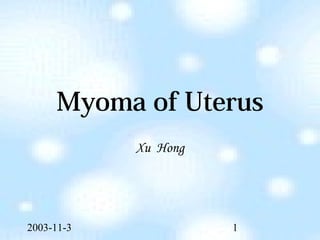13
- 1. 2003-11-3 1 Myoma of Uterus Xu Hong
- 2. 2003-11-3 2 Synonyms leiomyoma of uterus leiomyomas fibromyomas myofibromas fibroids fibromas myomas
- 3. 2003-11-3 3 Incidence Most common solid pelvic tumors Develop in 20 ¡« 25% of women during reproductive years 30 ¡« 50 years old
- 4. 2003-11-3 4 Correlative Factors An estrogenic milieu may be necessary Progesterone function Growth factor and their receptor £º epithelial growth factor £¨ EGF £© Insulin-like growth factor £¨ IGF £© platelet-derived growth factor puberty Çà´ºÆÚ menopause ¾ø¾ÆÚ estrogen ´Æ¼¤ËØ progesterone Ôм¤ËØ
- 6. 2003-11-3 6 Gross Appearance Rare only a single £¬ usually many exist Well-circumscribed £¬ nonencapsulated A pseudocapsule is present. The consistency is usually firm or even hard except when degeneration or hemorrhage has occurred. color £º light gray or pinkish white cut section £º an intertwining pattern or a whorl-like arrangement £» bulgy pseudocapsule ¼Ù°üĤ
- 7. 2003-11-3 7 Smooth muscle tumors of the uterus are often multiple. Seen here are submucosal, intramural, and subserosal leiomyomata of the uterus.
- 8. 2003-11-3 8 Microscopic Appearance Composition £º smooth muscle connective tissue The nonstriated muscle fibers are arranged in bundles of various sizes that run in multiple directions.
- 9. 2003-11-3 9 Classification £¨ 1 £© According to growth location £º ? Myomas on the body of uterus £¨ 90% £© ? Myomas on the cervix of uterus £¨ 10% £©
- 10. 2003-11-3 10 Classification £¨ 2 £© According to the relation to uterine muscle £º ? Submucous £¨ 10 ¡« 15% £© ? Intramural £¨ 60 ¡« 70% £© ? Subserosal £¨ 20% £© Few leiomyomas are actually of a single ¡°pure¡± type. ¡ª hybrids
- 12. 2003-11-3 12 Symptoms menorrhagia and prolonged menstrual period £º common Pelvic pain £º occurs in pregnancy if undergoing degeneration or torsion of a pedunculated myoma Pelvic pressure £º urinary frequency bowel difficulty £¨ constipation £© Spontaneous abortion Infertility menorrhagia Ô¾¹ý¶à pedunculated ÓÐµÙµÄ spontaneous abortion ×ÔÈ»Á÷²ú infertility ²»ÓýÖ¢
- 13. 2003-11-3 13 Signs A palpable abdominal tumour Pelvic examination £º uterus ¡ª enlarged and irregular £» hard
- 14. 2003-11-3 14 Degeneration Hyaline degeneration Cystic degeneration Red degeneration Sarcomatous change The others £º fat degeneration calcification the secondary infection Result from the diminished vascularity of the connective-tissue element
- 15. 2003-11-3 15 Red Degeneration Occasionally seen as a complication of pregnancy £¨ during pregnancy or immediate postpartum period £© The pathogenesis is unknown £¬ may be the result of the accumulation of blood in the tumour because of venous obstruction. The cut surface resembles raw meat. Clinical features £º a cause of pain £¨ acute £© fever rapid growth £¬ tender ²úÈìÆÚ
- 16. 2003-11-3 16 Here is a very large leiomyoma of the uterus that has undergone degenerative change and is red (so-called "red degeneration"). Such an appearance might make you think that it could be malignant. Remember that malignant tumors do not generally arise from benign tumors.
- 17. 2003-11-3 17 Sarcomatous Change Rare £º 0.4% ¡« 0.8% More common at 40 ¡« 50 years old Usually occur in intramural fiboids grow quickly vaginal bleeding
- 18. 2003-11-3 18 Diagnosis History Bimanual examination Ultrasonography £¨ B¨Cultrasound examination £© Hysteroscopy Laparoscopy Hysterography hysteroscopy ×Ó¹¬¾µ¼ì²é laparoscopy ¸¹Ç»¾µ¼ì²é
- 19. 2003-11-3 19 Differential Diagnosis Pregnancy Ovarian tumour Adenomyosis Malignant tumors of uterus ? sarcoma of uterus ? endometrial carcinoma ? cervical cancer
- 21. 2003-11-3 21 Observation and Follow Up Small £¬ asymptomatic fibroids need not be treated £¬ especially near menopause. Interval £º 3 ¡« 6 months
- 22. 2003-11-3 22 Medical Treatment Androgenic agents £º testosterone propionate GnRH-a £º ? induce a hypoestrogenic pseudomenopausal state ? not recommended for longer than 6 months ? ¡°add-back¡± regimens ±ûغ ·´ÏòÌí¼ÓÁÆ·¨£¬µæ±³ÁÆ·¨
- 23. 2003-11-3 23 Surgery Treatment £¨ 1 £© Indications £º greater than 10 weeks¡¯ gestational size menorrhagia £¬ lead to anemia have pressure symptoms grows rapidly failure of medical treatment
- 24. 2003-11-3 24 Surgery Treatment £¨ 2 £© Method £º Myomectomy¡ªconservative therapy preserve fertility significant risk of recurrence Hysterectomy¡ª radical therapy Subtotal hysterectomy hysterectomy ×Ó¹¬ÇгýÊõ myomectomy ¼¡ÁöÌÞ³ýÊõ Only true ¡°cure¡± for leiomyomas ´ÎÈ«×Ó¹¬ÇгýÊõ
- 25. 2003-11-3 25 Surgery Treatment £¨ 3 £© Approach £º ? trans-abdominal ? trans-vaginal ? laparoscopic or hysteroscopic
- 26. 2003-11-3 26 It is important to individualize the choice of therapy.
- 27. 2003-11-3 27 Uterine Leiomyomas Complicating Pregnancy impact on pregnancy £º abortion impact on delivery £º premature labour fetal malpresentation retained placenta placenta previa need for operative delivery £¨ birth canal obstruction £© postpartum hemorrhage Conservative treatment
- 28. 2003-11-3 28 Critical Points May be related to superabundant estrogen. Well-circumscribed £¬ nonencapsulated. Have a pseudocapsule. Can be classified into submucosal ¡¢ intramural and subserosal types. Different types have different features. Menorrhagia is common. Four degeneration types Individualized treatment £¬ include observation ¡¢ medical treatment and surgical treatment.



























